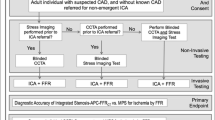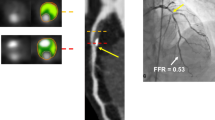Abstract
Background
Management of patients with suspected coronary artery disease (CAD) and inconclusive stress imaging test findings may result in invasive coronary angiography (ICA). Coronary computed tomographic angiography (CCTA) may be useful in defining the risk of CAD and adverse outcomes in this patient population, as well as in reducing the need for ICA.
Methods
We prospectively enrolled 199 sequential patients referred by cardiologists for CCTA after either inconclusive or nondiagnostic stress imaging tests. Before CCTA, physicians identified a “planned catheterization” group of patients who would undergo invasive angiography if CCTA were not available. After CCTA testing, patients were followed for ≥2 years. We established the added diagnostic value of the CCTA and its prognostic power in prediction of intermediate-term follow-up events in this patient population as compared to available historical and clinical predictors of CAD, stress ECG, and stress imaging test results using a multivariable Cox proportional hazards survival analysis.
Results
Both observed data and results of the multivariable model for the prediction of obstructive CAD (>50% stenosis), or major cardiac events (death MI or revascularization), demonstrated that clinical, stress ECG, and imaging results were weakly predictive, whereas CCTA was found to be a strong independent and incremental predictor of the absence of either significant CAD or MACE in this population. None of the 93 patients with normal CCTA scans had MACE events, whereas 18 patients with evidence of CAD on the CCTA results underwent revascularization. Overall, physicians planned ICA in 125 patients (63.0%); after CCTA, ICA was performed in only 32 (16.0%) cases over 2 years. In this population with no other highly effective noninvasive clinical tools for diagnostic and prognostic estimation, the overall negative predictive value of CCTA for either CAD > 50% or MACE for 2 years was 99%.
Conclusion
Observations from this prospective study demonstrate the significant added diagnostic value and prognostic potential of CCTA in patients with suspected CAD and either inconclusive or nondiagnostic stress test results in real-world settings. Normal CCTA results are associated with excellent intermediate-term prognosis in this clinical subset, and invasive angiography can be safely avoided in the majority of these patients when the results of CCTA are available.



Similar content being viewed by others
References
Guilbert JJ. The World Health Report 2006: Working together for health. Educ Health (Abingdon) 2006;19:385-7.
Detrano R, Gianrossi R, Froelicher V. The diagnostic accuracy of the exercise electrocardiogram: A meta-analysis of 22 years of research. Prog Cardiovasc Dis 1989;32:173-206.
Gibbons RJ, Balady GJ, Bricker JT, et al. ACC/AHA 2002 guideline update for exercise testing: Summary article. A report of the American College of Cardiology/American Heart Association Task Force on Practice Guidelines (Committee to Update the 1997 Exercise Testing Guidelines). J Am Coll Cardiol 2002;40:1531-40.
Heller GV, Bateman TM, Johnson LL, et al. Clinical value of attenuation correction in stress-only Tc-99m sestamibi SPECT imaging. J Nucl Cardiol 2004;11:273-81.
Koller D. Assessing diagnostic performance in nuclear cardiology. J Nucl Cardiol 2002;9:114-23.
Hamon M, Biondi-Zoccai GG, Malagutti P, Agostoni P, Morello R, Valgimigli M. Diagnostic performance of multislice spiral computed tomography of coronary arteries as compared with conventional invasive coronary angiography: A meta-analysis. J Am Coll Cardiol 2006;48:1896-910.
ACCF/ACR/SCCT/SCMR/ASNC/NASCI/SCAI/SIR 2006 appropriateness criteria for cardiac computed tomography and cardiac magnetic resonance imaging. A report of the American College of Cardiology Foundation Quality Strategic Directions Committee Appropriateness Criteria Working Group. J Am Coll Radiol 2006;3:751-7.
Raff GL, Gallagher MJ, O’Neill WW, Goldstein JA. Diagnostic accuracy of noninvasive coronary angiography using 64-slice spiral computed tomography. J Am Coll Cardiol 2005;46:552-7.
Austen WG, Edwards JE, Frye RL, et al. A reporting system on patients evaluated for coronary artery disease. Report of the Ad Hoc Committee for Grading of Coronary Artery Disease, Council on Cardiovascular Surgery, American Heart Association. Circulation 1975;51:5-40.
Gallagher MJ, Ross MA, Raff GL, Goldstein JA, O’Neill WW, O’Neil B. The diagnostic accuracy of 64-slice computed tomography coronary angiography compared with stress nuclear imaging in emergency department low-risk chest pain patients. Ann Emerg Med 2007;49:125-36.
Gibbons RJ, Abrams J, Chatterjee K, et al. ACC/AHA 2002 guideline update for the management of patients with chronic stable angina—summary article: A report of the American College of Cardiology/American Heart Association Task Force on practice guidelines (Committee on the Management of Patients With Chronic Stable Angina). J Am Coll Cardiol 2003;41:159-68.
Abidov A, Rozanski A, Hachamovitch R, et al. Prognostic significance of dyspnea in patients referred for cardiac stress testing. N Engl J Med 2005;353:1889-98.
Tilkemeier PL, Cooke CD, Ficaro EP, Glover DK, Hansen CL, McCallister BD Jr. American Society of Nuclear Cardiology information statement: Standardized reporting matrix for radionuclide myocardial perfusion imaging. J Nucl Cardiol 2006;13:e157-71.
WPS 2008 Computed Coronary Tomography Angiography: Indications and Limitations of Coverage and/or Medical Necessity. Wisconsin Physicians Service (WPS).
Iskandrian AE. The Achilles heel of SPECT imaging: The false-positive scans—or are they? J Nucl Cardiol 2006;13:747-8.
Schuijf JD, Wijns W, Jukema JW, et al. Relationship between noninvasive coronary angiography with multi-slice computed tomography and myocardial perfusion imaging. J Am Coll Cardiol 2006;48:2508-14.
Dorbala S, Hachamovitch R, Di Carli MF. Myocardial perfusion imaging and multidetector computed tomographic coronary angiography: Appropriate for all patients with suspected coronary artery disease? J Am Coll Cardiol 2006;48:2515-7.
Nicol ED, Stirrup J, Reyes E, et al. Sixty-four-slice computed tomography coronary angiography compared with myocardial perfusion scintigraphy for the diagnosis of functionally significant coronary stenoses in patients with a low to intermediate likelihood of coronary artery disease. J Nucl Cardiol 2008;15:311-8.
Lesser JR, Flygenring B, Knickelbine T, et al. Clinical utility of coronary CT angiography: Coronary stenosis detection and prognosis in ambulatory patients. Catheter Cardiovasc Interv 2007;69:64-72.
Cole JH, Chunn VM, Morrow JA, Buckley RS, Phillips GM. Cost implications of initial computed tomography as opposed to catheterization in patients with mildly abnormal or equivocal myocardial perfusion scans. J Cardiovasc Comput Tomogr 2007;1:21-6.
Fraker TD Jr, Fihn SD, Gibbons RJ, et al. 2007 chronic angina focused update of the ACC/AHA 2002 guidelines for the management of patients with chronic stable angina: A report of the American College of Cardiology/American Heart Association Task Force on Practice Guidelines Writing Group to develop the focused update of the 2002 guidelines for the management of patients with chronic stable angina. J Am Coll Cardiol 2007;50:2264-74.
Nair D, Carrigan TP, Curtin RJ, et al. Association of coronary atherosclerosis detected by multislice computed tomography and traditional risk-factor assessment. Am J Cardiol 2008;102:316-20.
Abidov A, Hayes SW, Friedman JD, et al. Silent ischemia revisited: Results of 10-year follow-up in patients with symptomatic and silent exercise-induced ischemia on myocardial perfusion SPECT. J Am Coll Cardiol 2008;51:A171.
Heller GV, Links J, Bateman TM, et al. American Society of Nuclear Cardiology and Society of Nuclear Medicine joint position statement: Attenuation correction of myocardial perfusion SPECT scintigraphy. J Nucl Cardiol 2004;11:229-30.
Johnson LW, Krone R. Cardiac catheterization 1991: A report of the Registry of the Society for Cardiac Angiography and Interventions (SCA&I). Cathet Cardiovasc Diagn 1993;28:219-20.
Pundziute G, Schuijf JD, Jukema JW, et al. Prognostic value of multislice computed tomography coronary angiography in patients with known or suspected coronary artery disease. J Am Coll Cardiol 2007;49:62-70.
Min JK, Shaw LJ, Devereux RB, et al. Prognostic value of multidetector coronary computed tomographic angiography for prediction of all-cause mortality. J Am Coll Cardiol 2007;50:1161-70.
Gaemperli O, Valenta I, Schepis T, et al. Coronary 64-slice CT angiography predicts outcome in patients with known or suspected coronary artery disease. Eur Radiol 2008;18:1162-73.
Leber AW, Knez A, von Ziegler F, et al. Quantification of obstructive and nonobstructive coronary lesions by 64-slice computed tomography: A comparative study with quantitative coronary angiography and intravascular ultrasound. J Am Coll Cardiol 2005;46:147-54.
Hoffmann MH, Shi H, Schmitz BL, et al. Noninvasive coronary angiography with multislice computed tomography. JAMA 2005;293:2471-8.
Boden WE, O’Rourke RA, Teo KK, et al. Optimal medical therapy with or without PCI for stable coronary disease. N Engl J Med 2007;356:1503-16.
Acknowledgments
We are indebted to the CT technicians and nurses, research coordinators, and follow-up team in the Center for Advanced Cardiac Imaging, William Beaumont Hospital. We are especially grateful to Mr. Ralph Gentry, our Chief Cardiac Imaging technologist, for his expert technical assistance with the study data acquisition and collection. This research was made possible by research grant support from Florine and J. Peter Ministrelli.
Funding
The Florine and J. Peter Ministrelli Center for Advanced Cardiovascular Imaging, Royal Oak, Michigan.
Author information
Authors and Affiliations
Corresponding author
Additional information
Clinical Trials Registry: ID# NCT000465335.
See related editorial, doi:10.1007/s12350-009-9125-6
Rights and permissions
About this article
Cite this article
Abidov, A., Gallagher, M.J., Chinnaiyan, K.M. et al. Clinical effectiveness of coronary computed tomographic angiography in the triage of patients to cardiac catheterization and revascularization after inconclusive stress testing: results of a 2-year prospective trial. J. Nucl. Cardiol. 16, 701–713 (2009). https://doi.org/10.1007/s12350-009-9117-6
Received:
Revised:
Accepted:
Published:
Issue Date:
DOI: https://doi.org/10.1007/s12350-009-9117-6




